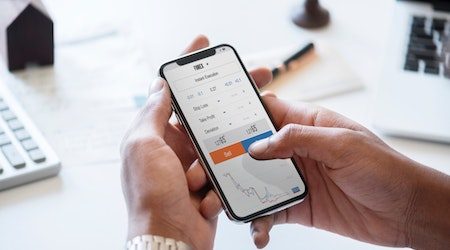Book value = Total assets – Total liabilities
The market value and book value of a company can help you evaluate the true value of its stocks and the firm’s potential for growth.
What is the difference between book value and market value?
Book value and market value are essentially mathematical equations that help you gauge the true worth of a stock and the financial might of the company behind it.
The market value of a company is the price of a share of its stock multiplied by the number of outstanding shares in the open market. Book value is the difference between a company’s total assets and liabilities. Comparing the two can help you determine whether a stock is undervalued, overvalued or generally priced correctly.
| Book value | Market value | |
|---|---|---|
| Definition | A company’s worth based on its financial balance sheets. | What investors are willing to pay for a stock in the primary market |
| What does it measure? | The difference between a company’s total assets and total liabilities. | Current stock price multiplied by all outstanding shares in the market. |
| How it’s calculated | Total assets – total liabilities | Current stock price per share X total number of outstanding shares. |
| How often it changes | Often reported by companies quarterly or annually | Can change daily |
What is book value?
Book value is theoretically what all shareholders would get if a company liquidated all its assets and paid off all its liabilities. This is why book value is calculated as the difference between a company’s total assets and total liabilities. Assets include all the company’s financials, including:
- Cash
- Short-term investments
- Accounts receivable
- Physical property such as real estate, inventory and equipment
- Intangibles like brand names and intellectual property if listed on balance sheet
Total liabilities are everything the company needs to pay back. This can include various liabilities such as:
- Loans and other debt
- Accounts payable
- Deferred taxes
But book value has its limits. For instance, it’s sometimes difficult to measure the value of a company’s intellectual property and other intangibles. You may also need to gather several financial documents to determine the impact of a company that has been depreciating its assets.
Book value formula
You can find the book value of a company by subtracting its total liabilities or what it owes from its total assets. Here’s the formula.
So how do you find a company’s total assets and liabilities? This information is found on a company’s balance sheet, which is typically found in the investor relations section of a company’s website. You can also try looking up “Company ABC balance sheet” followed by the current year on Google.
Let’s calculate the book value of a major company like Microsoft. These values are taken from its Earnings Release FY21 Q2.
- Total listed assets: $304,137 million
- Total liabilities: $173,901 million
- Total assets minus total liabilities: $130,236 million
You can also skip the math as book value is often reported as “shareholder’s equity” or “stockholder’s equity” on a company’s balance sheet.
What is book value per share (BVPS)?
If you divide the book value by the number of outstanding shares, you get the book value per share. Outstanding shares are all of a company’s stock shares that people hold in the stock market. This can help you determine whether a stock is undervalued or overvalued. When book value per share is higher than a stock’s market price, it could mean the stock is undervalued.
According to Microsoft, the company had 7,542,215,767 outstanding shares as of January 21, 2021. So its book value per share is roughly $17.27.
What is market value?
The market value of a company is the current price of a single share of its stock multiplied by the number of outstanding shares held by all shareholders in the market. This is also known as the company’s market capitalization.
It essentially tells you what investors are willing to pay for a company’s stock based on all publicly available information. It also tells you how much shareholders would get if the firm decides to liquidate the company.
Market value formula
Also called market capitalization, the market value of a company is the price of a single share of stock multiplied by the number of outstanding shares. Here’s the formula.
Market value = Price of a single share of company stock x Number of outstanding shares trading in the market
Let’s revisit Microsoft. The price of a single share of Microsoft stock is $237.58 as of March 23, 2021, when the Nasdaq closed. It currently has roughly 7,542,215,767 outstanding shares. So if you multiply these 2 figures, Microsoft has a market value of $1.79 trillion.
How to interpret book value and market value
The market value and book value of a company can vary by a large margin. Comparing these 2 metrics can help you determine whether a stock is overvalued, undervalued or rightly priced in the market.
Book value is greater than market value
If the book value of a company is greater than its market value, it could mean investors aren’t confident about the company’s financial performance or future.
Remember, book value is the value of a company based on its books or balance sheet. Market value depends on what investors are willing to pay for the company’s stock. So if book value is greater than market value, it could mean investors don’t believe the company is worth the price on its books.
But it could also mean the market is wrong in its valuation of a stock, so value investors may seek out these companies in hopes that they can buy the stock and sell it for more than what the market currently values it at.
In other words, they’d be buying stocks at a discount in hopes that it will improve in the future. This scenario might behoove long-term investors, but active day traders may not benefit much from companies that have greater book values than market values.
Market value is greater than book value
In some instances, market value may be higher than book value. In our previous example, we found Microsoft has a much larger market value ($1.79 trillion) than book value ($130,236 million).
This could mean the company’s stock is overvalued, which in turn can mean that investors are confident in the company’s future earnings potential. In such cases, investors would be confident paying more for a stock because they believe the company could boost its financial strength based on its current state and plans for the future. But the downside is that the company’s stock may be selling for more than it’s actually worth.
Book value is equal to market value
If a company’s book value is equal to its market value, it could simply mean that the market is accurate in its valuation of its stocks. And investors are paying for exactly what the stocks are worth.
This could be a good sign for risk-averse investors who just want to buy stocks for what they are worth and aren’t very interested in timing the market. In other words, this situation may appeal to investors who don’t want to gamble on whether a stock is overvalued or undervalued.
Market value and book value are two useful metrics that can help you determine the true value of a company’s stock. But before you can buy a company’s stock, you need to open a brokerage account.
Bottom line
Book value and market value can help you gauge a stock’s true value. This can aid in your decision making when buying and trading stocks, and it can guide your investment strategy.
Frequently asked questions
Sources
More guides on Finder
-
7 oil tanker stocks to watch
Want to invest in oil tanker companies? We’ve put together a list of oil tanker stocks you should keep your eye on.
-
4 diamond stocks to watch
Want to invest in diamond companies? We’ve put together a list of diamond stocks you should keep your eye on.
-
8 sports stocks to watch
Want to invest in sports companies? We’ve put together a list of sports stocks you should keep your eye on.
-
What is a stop-loss order?
Learn how a stop-loss order can help you limit losses or lock in profits when trading.
-
Best renewable energy stocks
These are the best renewable energy stocks to buy now in Canada.
-
10 gold stocks to watch
Check out some of the best gold stocks to buy right now in Canada based on company performance.
-
Best stocks to buy right now in Canada
Finder’s unique algorithm found the 20 best TSX stocks to buy right now.
-
Guide to 10 of the best ETFs in Canada
Learn how to choose the best ETFs to buy right now in Canada.
-
What is micro-investing?
Round up your spare change into big bucks with Canadian apps designed for saving, depositing and investing.
-
Best investment accounts in Canada
Compare defensive and growth investments to find the best investment accounts in Canada for you.







